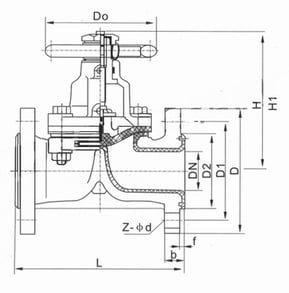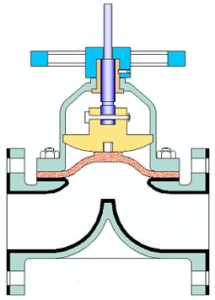Rubber Diaphragm Valve
Rubber Diaphragm Valve
Size Range: DN32~DN250
Class: PN16/150LB
Material: Cast Iron, WCB, Stainless Steel;
Lined Material: Rubber
Flange Dimension: ASME B 16.5, BS 12627
What is a rubber diaphragm valve?

This is a type of diaphragm valve in which the diaphragm is lined with rubber material. This valve is designed with a flexible diaphragm used to control the flow of fluid. Rubber diaphragm valve manufacturers design this type of valve for use in the opening, closing, or throttling fluid flow. The rubber diaphragm component is designed to move up and down to regulate the fluid flow. Rubber diaphragm valves are best for use in low-temperature applications due to the low melting point of the rubber material. This type of valve can be used in various applications ranging from solids, slurries, liquids, and gaseous substances.
The design employed in rubber diaphragm valves makes them best for use in solid particulate matter. Relative to other valve types, this valve employs a simple design and has minimum contact between internal components. As such, the buildup of solid particles inside the valve is rare as well as minimal wear of parts. Such properties makes rubber diaphragm valves suitable for use in pharmaceutical and food applications, pulp and paper, and electronics manufacturing among others.
Components of a rubber diaphragm valve
Handwheel/actuator
A handwheel is a component used in manually operated rubber diaphragm valves and it is where the valve operator applies force to open or close the valve. The actuator is used in automatically operated rubber diaphragm valves. The actuator provides the torque needed to open and close the valve.
Stem
This is a component that connects the handwheel/actuator to a compressor. Rubber diaphragm valve manufacturers design the stem to be either indicating or non-indicating. For the non-indicating stem, a handwheel is used to rotate stem bushing to engage stem threads. This helps a compressor to move up and down. The indicating stem has a longer stem going beyond the handwheel. It works to move the compressor up and down.
Compressor
The compressor has two ends in which one end is connected to the stem and the other end is connected to a diaphragm. As such, the compressor gets its power to operate from the stem. Once the stem is rotated via the handwheel, it transfers that motion to the compressor. This makes the compressor force the diaphragm either upwards or downwards to allow fluid flow or to stop the fluid flow as necessary.
Valve body
This is the part of the valve used to house internal components. The body is made of strong materials such as stainless steel and carbon steel to ensure the valve has high strength enough to withstand fluid pressure and impact damage against falling objects. The body also contains the valve inlet and exit ports.
Bonnet
This is the part of the body that is placed on top of the valve body. The bonnet is used to house internal parts of the valve such as stem, compressor, and handwheel mechanisms. The bonnet and body are made of the same material and connected using bolts or screw threads.
Diaphragm
The diaphragm is a component that moves up and down on the valve body to allow and obstruct fluid flow respectively. The diaphragm also helps to prevent non-wetted parts of the valve against the fluid since the fluid flows underneath.
Position indicators
These are visual guides installed on the valve to help determine when the valve is closed or open. Indicator can be stem, light or switch.
How does a rubber diaphragm valve work?
A rubber diaphragm valve operates by turning the stem via the handwheel or actuator. When the handwheel/actuator is rotated in the clockwise direction, it makes the stem rotate in the same direction as it moves upwards. The stem is connected to the valve compressor and thus as it moves upwards it causes the compressor to lift together with the diaphragm. The diaphragm then leaves the valve open which then allows fluid to flow through the valve. To close the valve, the handwheel/actuator rotates in the anticlockwise direction which then makes the stem and compressor as well as the diaphragm to move downwards. This forces the diaphragm to close the flow of fluid through the valve. For throttling use, the diaphragm is moved slightly upwards by rotating the handwheel/actuator making the valve partially open for some amount of fluid to flow.
Types of rubber diaphragm valves
Straight through rubber diaphragm valve
This is a rubber diaphragm valve designed with a flat bottom body. This design of the valve helps to reduce fluid flow impediment as the fluid flows in a straight path. Rubber diaphragm valve manufacturers design this valve such that it closes the fluid flow when the diaphragm fully touches the bottommost part of the body. As such, this valve is designed with a more flexible material. However, the diaphragm component of this valve has a short life service and thus it is replaced frequently. Straight-through rubber diaphragm valves are best for semi-solid media like sludge, slurries, and viscous fluids. Such types of media need minimal to no obstruction on the valve flow path. Also, this rubber diaphragm valve has the advantage of being bi-directional since there are no saddles to block fluid flow if flow directions is reversed.


Figure: Straight through rubber diaphragm valve.
Weir rubber diaphragm valve
This is one of the most common types of rubber diaphragm valves. Rubber diaphragm valve manufacturers design this valve with a raised lip or saddle. It is on this saddle or lip where the diaphragm is pressed to create a firm seal against fluid flow. Weir rubber diaphragm valves are good in controlling fluid flow even where there are small flow rates. These valves are also very good in throttling flow applications.
Rubber diaphragm valve manufacturers design some of these valves with two compressor systems to create a relatively small path at the valve center. In such valves, the inner compressor raises the central part of the diaphragm during the first stem travel increment instead of the whole diaphragm. After the inner compressor is fully open, the outer compressor is raised along the inner compressor providing extra throttling to fluid flow. Rubber diaphragm valve manufacturers recommend the use of this valve in clean and homogenous liquids and gases. This is to avoid the buildup of sediments as well as gumming up of viscous fluids on the saddle. These valves can also be used to work on abrasive, hazardous, and corrosive fluids.

Figure: Weir rubber diaphragm valve.
Biotech rubber diaphragm valve
This is a rubber diaphragm valve designed for handling fluids that contain microorganisms as well as other biological matter. This type of valve is installed in pipes consisting of fermenters, bioreactors, freeze-thaw equipment, and chromatography skids. These valves are used in various applications of biotechnology such as agriculture, medicine, food science, and the pharmaceutical industry.
Hygienic rubber diaphragm valve
This is a rubber diaphragm valve that is meant for use in conveying products for human consumption. Rubber diaphragm valve manufacturers design this valve such that there are few areas in the valve where fluid can stagnate. These valves are easy to clean and thus are often used in the food and beverages processing industries.
Sanitary rubber diaphragm valve
This is a rubber diaphragm valve used mostly in applications that need a high level of fluid cleanliness and purity like dairy, winemaking, pharmaceuticals, foods, and beverages processing. Rubber diaphragm valve manufacturers design these valves to enhance an aseptic environment for the media flowing where no bacteria, viruses, and fungi can thrive. These valves can handle semi-solid, gaseous, and liquid media.
Types of Considerations before purchasing a rubber diaphragm valve diaphragm valves
Area of application
Rubber diaphragm valve manufacturers produce various types of these valves for use in different applications. The valve is designed to best fit a specific application. For example, valves meant for foods and pharmaceutical applications are easy to clean and free from dirt. Also, such valves should be made of materials that cannot affect the media being transported.
Operating pressure
These valves are designed to withstand wide range of pressure. Using the valve at the wrong pressure level may cause problems such as leakage which can further cause losses to the media being transported or cause environmental damage.
Type of media
There are various types of rubber diaphragm valves. Some of these valves are recommended for use in certain media such as slurries and viscous fluids. For example, a straight-through rubber diaphragm valve would do very well in slurries and viscous fluids relative to the weir-type valve.
Applications of rubber diaphragm valves
- Rubber diaphragm valves are used in corrosive applications.
- They are used in water supply.
- These valves are used in sewage treatment applications.
- Rubber diaphragm valves are used in chemical processing plants.
- They are used in food and beverage processing lines.
- Rubber diaphragm valves are used in paper and pulp manufacturing.
- They are used in pharmaceutical applications.
- They are used in electronics manufacturing industries.
Advantages of rubber diaphragm valves
- Rubber diaphragm valves can be used as on and off and throttling valves.
- They are resistant to corrosion.
- They can be used in different applications involving slurries, liquids, and gases.
- Rubber diaphragm valves are versatile as they can be used in various industries.
- These valves are easy to clean and repair.
- Rubber diaphragm valves are bi-directional allowing fluid flow in either direction.
- They are free from fluid leakage due to tight shut-off.
- They can be used in viscous fluids.
- They can be operated manually or by use of actuators.
Disadvantages of rubber diaphragm valves
- Rubber diaphragm valves cannot be used at high temperatures as the rubber material can be damaged.
- These valves tend to limit hydrostatic fluid pressure.
- They tend to alter pipe drainage especially the weir rubber diaphragm valve due to the saddle.
Troubleshooting rubber diaphragm valve
Ruptured diaphragm
- The rubber material is worn out. Replace the diaphragm.
- Too much operating pressure. Ensure the operating force is at the level recommended by the rubber diaphragm valve manufacturer. Ensure the closing mark when operating the valve is not exceeded.
- Foreign materials clogged between the valve seat and the diaphragm. Open the valve according to the instructions given by the rubber diaphragm valve manufacturer and clean off the foreign materials.
- The opening height is too large. Ensure the opening height does not exceed the level recommended.
The rubber diaphragm valve does not operate
- Valve disc and diaphragm detached. Avoid excessive opening and repair and or replace the diaphragm as necessary.
- Broken stem. Replace the stem.
- Damaged stem threads. Replace the stem.
The valve cannot close
- Low operating torque. Ensure the operating torque is as recommended.
Leakage at the body-pipe connection
- Loose bolts. Tighten the bolts to the torque recommended by the rubber diaphragm valve manufacturer.
- Worn out gasket. Replace the gasket.
Summary
A rubber diaphragm valve is a type of valve that is lined with a rubber material in its interior. This type of valve is meant for various applications but only at low temperatures since high-temperature damages the rubber material. Rubber diaphragm valve manufacturers make this valve for use as a manual or automatic valve. The operation of this valve starts with the application of torque on the handwheel or from the actuator. This torque drives the valve stem which then forces the compressor and diaphragm to move upwards or downwards to open or close fluid flow respectively. This valve is also used in throttling applications in which the diaphragm is slightly lifted upwards leaving the valve open for some amount flow rate.
Rubber diaphragm valve manufacturers produce various types of valves which include straight-through rubber diaphragm valves, weir rubber diaphragm valves, biotech rubber diaphragm valves, sanitary rubber diaphragm valves, and hygienic rubber diaphragm valves among others. The areas of applications of these valves include water supply, sewage treatment, paper and pulp, pharmaceuticals, foods and beverages, and chemical processing among others. Advantages of using a rubber diaphragm valve are corrosion resistance, zero leakage, versatility, easy to clean and repair, and automatic or manual operation.

